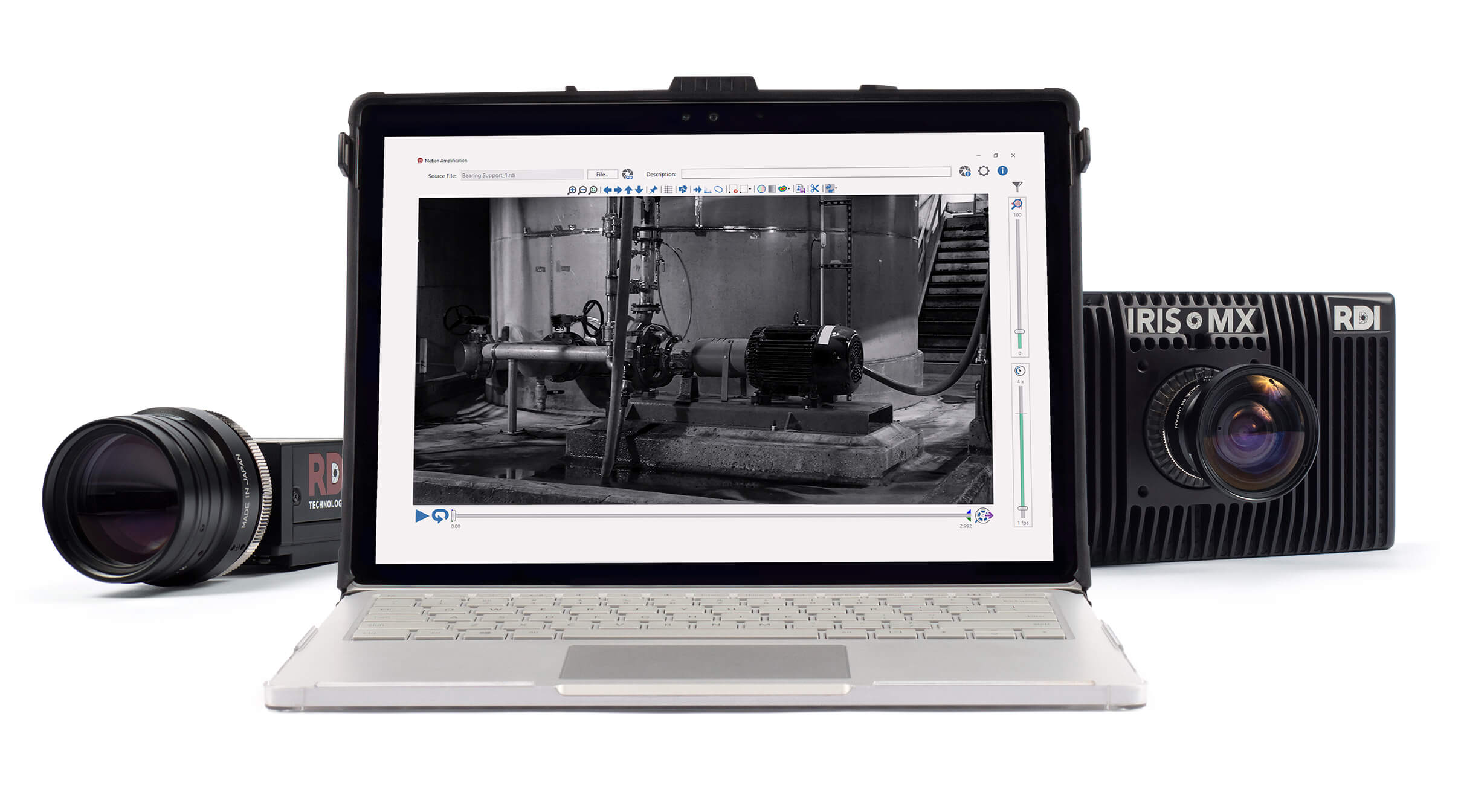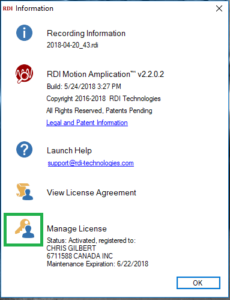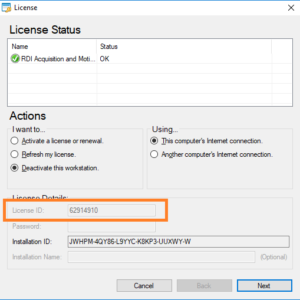
Have you met our friend, Steve?
Steve Mould, the renowned British scientist, has earned acclaim for his ability to render science accessible through his YouTube channel, boasting a staggering 2+ million subscribers. Armed with a physics degree from the prestigious University of Oxford and complemented by a background in comedy, Mould has forged a path in popularizing science, making it both understandable and enjoyable for audiences worldwide. With captivating weekly experiments, he not only educates but also inspires curiosity, fostering a community eager to delve into new realms of knowledge.
Steve Mould explores Motion Amplification® with RDI CEO and Founder, Jeff Hay
In a compelling overview, Mould now ventures into the realm of cutting-edge technology exploring the innovative Motion Amplification® system by RDI Technologies, unravelling its profound significance in the realm of maintenance for vibration-affected objects. Motion Amplification® represents a paradigm shift in vibration analysis, transcending traditional methods with its ability to provide a holistic view of structural dynamics. Unlike conventional point measurements, Motion Amplification® captures the entirety of motion fields, rendering even the subtlest vibrations visible to the naked eye. This transformative technology not only bolsters diagnostic capabilities but also streamlines maintenance protocols, enabling early fault detection and precise issue pinpointing. The result? A substantial reduction in downtime and maintenance costs, marking Motion Amplification® as an indispensable tool in modern engineering and maintenance practices.
Watch the video on YouTube
Video Transcription:
Suppose that you manage a factory that makes widgets, you’ve got a spinning thing over there, you’ve got an up and downy thing over here, it’s a complex setup that produces a lot of vibrations, so you’re quite reasonably concerned that one day your factory could shake itself to bits like a small vibration here may cause a bolt to come loose, which causes even more vibrations that leads to metal fatigue over here, which leads to even larger vibrations, it’s a snowball effect.
So you wanna catch the vibrations early before they become a problem, before they’re even visible to the human eye, so what do you do? Well, you could put some sensors on things that you’re worried about, so maybe you put an accelerometer on this pipe over here that you’re worried might be moving up and down too much, and that sensor supplies you with data and you plot a graph and you can see it moving up and down and it’s within limits and you can monitor it, and it’s fine.
But what if there’s a part of the factory you forget to put a sensor on because you don’t think it’s a concern? What if you could take millions of sensors and just throw them across your factory and capture everything? It turns out you can, and in fact, you carry a set of these sensors with you all the time, I’m talking about your phone, specifically the camera in your phone, that chip that gathers light for the picture, the CMOs chip is made of millions of individual sensors, one for each pixel, well I suppose three for each pixel actually.
In reality, you’re probably gonna wanna use something better than your camera phone selling industrial with a global shutter. So you get a camera and you take some videos of your factory, some really wide shots to begin with, make sure you capture absolutely everything, but if what you’re looking for is vibrations that are so small, they’re not perceptible with human vision, then how can a camera see these vibrations?
That’s where Motion Amplification® comes in, in fact, all the footage I’ve shown you so far is motion amplified, for example here, you can see side-by-side the original footage and the motion amplified footage. The original footage doesn’t look like it’s moving at all, but there is a subtle movement information in there that’s been amplified on the other side. In fact, an original video can contain sub pixel movements and still have that information amplified, so you don’t even have a hard edge sweeping across several pixels, instead, you’ve got a line of pixels that are getting darker while the neighboring pixels are getting lighter and you can interpret that information as movement and amplify it, it’s incredible really, especially when you consider if you’re extracting this information against the background of noise, all digital images and videos contain a bit of noise, which is a fancy way of saying random fluctuations in brightness for individual pixels.
I spoke to Jeff Hay at RDI Technologies who created the Motion Amplification® system that’s used in industrial sector.
Jeff: I started in astronomy, thought I was gonna be an astronomer, but I think I had a conversation with my advisor that was about being gainfully employed, you know remarkably the problem set’s kind of the same, you know what I mean? You’re using the camera to figure out something about some object that’s, you know, kind of at a distance, the other hobby that I had, I was the photo editor for my university newspaper, and so I’ve got a photography background as well, so all these things sort of just started to come together, you know it’s no secret where I ended up.
Jeff: Even a megapixel camera, which is by today’s standards, kind of small and in resolution, that has a million sensors in it, you can blanket an object with sensors and measure everywhere, but when you have sort of like a motor and a pump, you know, they’re connected, the shafts are connected at something that they call a coupling, which is just essentially connecting those two pieces of equipment, and if one side, if for example, the pump is going up while the motor is going down, that’s misalignment and that’s bad, you know, so lots of times that things are moving together, that’s some indication that that’s good, that’s all right, and sometimes when they’re opposing each other, that’s where the problems come in.
Steve: If you’ve got a 50 frames per second camera and you’ve got something that’s vibrating 15 times a second, you may not pick it up, do you have to worry about that sort of thing?
Jeff: Yeah, so usually the rule of thumb is you have to sample, you have to take data at a rate twice the frequency you’re interested in.
With this system you can look at the raw data as well, like you can say, look, tell me what’s going on with these pixels here, I’m interested in the vibrations at that point, and you can see a nice graph and that’s really important, but I’d also say that this summarized visual representation, that’s so easily digested by the human visual cortex is also really important because human brains are better than computers at certain tasks, maybe not forever, but it’s true for now, which is why we use human brains to train artificial intelligence in things like computer vision.
This is a bit of a diversion, but when you log onto a website and you have to prove that you’re human and not a robot, you fill in a CAPTCHA, and in the old days that used to be two words that were garbled in some way, and you had to type out what the words were, an easy task for human vision, a hard task for computers, but actually only one of those words was to test whether you are a human, the other word was something that Google was struggling with as part of their book digitization project.
So here’s a word we don’t recognize in a book, we’re gonna outsource it to a human through the CAPTCHA process, and it doesn’t just help with that one word in that one book, it also trains the AI to be able to recognize that kind of word in future. By outsourcing word recognition to humans in this way, Google were able to blaze through their book digitization projects, which is why you don’t see these word CAPTCHA anymore, so what do you see now?
Well, for a while it was numbers if you remember, and it would be a picture of a number that look suspiciously like a blurry photograph of a front door, and guess what? That was helping Google maps to identify addresses through pictures, taken from Google street view, these days the CAPTCHA task, it tends to involve something like click on all the images that contain a road sign or click on all the images that contain a bus, and guess what, that’s because Google’s parent company has an autonomous vehicle project and they need human brains to help them train their artificial intelligence, to recognize things like road signs and buses.
Interestingly, those CAPTCHAS are real time, so if you’re asked to identify a road sign for example, that’s because there’s a car out there on the street at that moment that needs to know that that’s a road sign, so if you see that you need to act quickly, otherwise someone could get hurt, that last bit isn’t true, or is it? It isn’t.
But anyway, the point is, if you can take your data and turn it into something visual, you might be able to outsource some of the processing of that data to a human brain that can produce remarkable insights without even breaking a sweat. And by the way, having this visual representation really helps when you’re trying to persuade superiors to spend some money.
Jeff: So if you go to somebody and you show them a plot on a graph and you say, man that machine is gonna come apart, you know, that’s a hard, you know, but if you can show them that it’s lifting up off the ground or it’s cracked, or you know, that’s kind of an element to it as well.
Steve: You talked about having, you got some footage of engines and things like that.
Jeff: We’ve got car engines, we’ve got some more common, you know, sort of everyday stuff that we could do, I think it would be a little bit more universal to people.
Jeff is understandably reluctant to talk about the finer technical details of how the technology works, but I really wanted to see if I could create motion, amplified video of my own.
Watch the video to see how it turned out.





